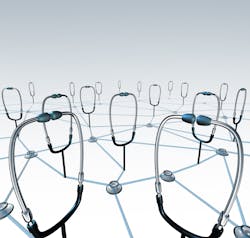Care Everywhere Adding Use Cases for Epic Users
Although nonprofit HIEs are the heart of regional interoperability efforts, many provider organizations continue to rely on connected networks from their EHR vendors, which act as private HIEs, to gather data on patients and for care coordination. For instance, Epic’s Care Everywhere is used for 220 million patient record exchanges every month, 50 percent of which are with platforms other than Epic.
Allison Weathers, M.D., a neurologist and associate chief medical information officer at Cleveland Clinic, recalls several years ago seeing a patient who had recently been to a hospital in Dallas but wasn’t sure what tests had been done. “With Care Everywhere I was able to ping Parkland Hospital in Dallas, and within seconds I had her MRIs, her ECGs and the full notes,” Weathers recalls, “and it completely changed the whole visit — what I was able to know and what I was able to do for her. That was my very first Care Everywhere experience and it immediately spoke to the power of this tool.”
Weathers notes that Care Everywhere allows medication, allergy, and immunization records from other health systems to be presented to the providers automatically in the chart, and the providers can easily review them and do medication reconciliation.
There is a sea change under way in terms of how providers think about importing data from other organizations. “A few years ago we would say we want this data, but it’s not our data, so we’ve got to keep it segregated, and in a walled-off area of the EHR,” Weathers says. “People thought that was the safest thing to do because we don’t know the quality of it. We don’t want to mix it with ours. We don’t want to be responsible in that same way. Now I would say we have evolved to where we say that unless that outside MRI is right next to our MRI, where we go to look in the EHR, people are going to miss it. Now, everybody is shifting over to expecting to see these data points.”
Five years ago, she adds, Care Everywhere would have been used much more for sharing with other health systems using Epic. But in the Cleveland market, several health systems use other EHRs and they are exchanging data regularly. “We’ve made such strides,” Weathers adds. “The experience is still a little bit different for data that’s pulled in from non-Epic clients. It doesn’t come across in quite the same way. It’s not quite as integrated. But I think it’s getting better by leaps and bounds, and CliniSync, which is the Ohio HIE, has worked very hard to try to get over some of the barriers and have the data come over in a usable way.”
Matt Doyle, Epic’s lead developer for Care Everywhere, says one feature that is just being launched based on user feedback involves looking at imaging results across settings to avoid duplicative testing.
“Some researchers have estimated that up to 8 percent of radiology exams are unnecessary, and duplicative testing is one of the big drivers behind that,” he says. If someone comes into the emergency department with a migraine, physicians are likely to order imaging tests. But maybe that person just had that test done two weeks ago somewhere else. “If I can see that result, I don’t need to repeat the procedure,” Doyle adds. “Now, at the moment of ordering, Epic can say, ‘Hold on before you complete this order. Did you know your patient just had this test a week and a half ago? We will link you directly to the radiologist’s report.’”
Epic is always working on new functionality for Care Everywhere, Doyle says. “One that I’m personally excited about is exchanging genetic variants. When you do genetic testing on a patient, usually you don’t look at the whole genome; usually, there are just little snippets that indicate poor metabolizer of a certain drug or at elevated risk of a certain type of cancer. And many of our customers do genomic testing right now and have that information. So we’ve been working with them to understand how do we exchange that between health systems? And it’s not just a technology question. It’s not just how do I pick it up from here and move it over there? But it’s really about how you work with geneticists to understand what’s important to them, and make sure that we’re going to meet their needs.”
Another use case that Weathers is excited about involves social determinants of health. “If a patient was seen here, when we’ve collected all their social determinants of health information, such as housing instability, and they show up in a MetroHealth clinic, that information is immediately known and can be used by their care coordinators, who are also starting to leverage Care Everywhere to send referrals to social safety net organizations in the community. I’m thrilled that we’re thinking more around those aspects of care for patients.”
Weathers sits on the Care Everywhere governing council, which provides feedback to Epic on features and priorities. “It’s a two-way street. Epic brings us in as a sounding board for advice to review areas of their development. We can give our thoughtful inputs.” The power of the group was demonstrated this year around COVID, she says. “Care Everywhere has traditionally been a clinical tool but not a research tool. But with the public health emergency, there was a powerful need, so the group was able to be leveraged in a thoughtful way to consider how we could start to branch into research with the right guard rails,” she adds. “What should that look like? We were able to be key for those discussions, whereas Epic might not have been willing to allow that access or pursue that use case if we weren’t there.”


